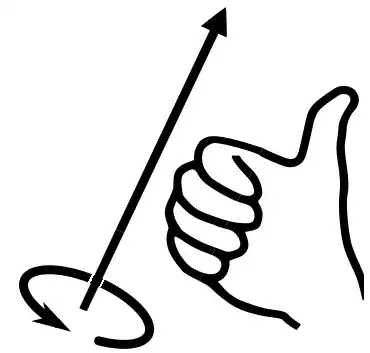Apparently, there seems to be no agreed upon definition of clockwise in 3D space - but an a clear agreement regarding the meaning in a plane "seen from above"
As I am starting to answer, I have no idea what is the correct answer,
if any. It is the "if any" that gets me started on this topic. I am
certainly not an expert, I never could tell my left from my right,
especially after having physics classes, but I am looking for the
available evidence.
To be honest I got actually very confused by John Rennie's answers, because I did not see the need to introduce yet another device, which you have to orient like the first, but not so naturally ... At least there is only one kind of clocks (except for funny souvenirs), while there are two kinds of hands to add to confusion. Also there is only one natural way to look at a clock, while there is no specific or normalized way to look at your hand, though having the thumb first is the natural position ... !
The word "clockwise" is used more than 800 times on physics.stackexchange.com
according to the very approximative figures of google (I used:
clockwise site:physics.stackexchange.com). This adverb must have some
relevance to physics.
When searching the web, or wikipedia, for a formal definition of
(counter-)clockwise in 3D, there seems to be none to be found. the answer by @Emilio is close to mine as he does seem to consider that the adverb "clockwise" has a well defined meaning without further precision.
The Internet being somewhat too large a place for me, I looked at
the uses of this adverb on physics.stackexchange.com. I even limited
myself to the first twenty answers from Google, as this takes
considerable time. Be my guest to do more.
Many uses are simply informal. Wich way does this or that turn when
you (un)screw or look at its rotation (like a clock). Bicycle pedals
is a good example. In many other cases, it is only used to indicate
changes in the sign of angular velocity, with corresponding changes in
the sign of other quantities, without any precise chiral information.
Note, for example, qthat when talking of hurricanes, it is always rotation as seen from above, like a clock seen from the front.
In Vector Nature Of Angular Velocity, the use is
clearly a 2D planar use, about a plane seen from above. The vector
considered does follow the right-hand rule. But it is not construed as
a definition of clock-wise rotation in 3-D.
The same is true in Alkali atom in oscilating electromagnetic field. Indeed, it talks of counter-clockwise rotation as it look at the right
hand from the end of the thumb.
In the answer to question
What is negative angular acceleration?, things are a bit
confused as it mentions the right hand rule, but seems to describe the
opposite. Then it also defines clockwise as the positive rotation,
while it is usually considered negative in mathematics (well, it did
in my school times, but I would not know the current fads). Again,
this is not construed as a definition of clockwise in 3D.
Question Lenz' law versus $-\frac{d\Omega}{dt}$ uses
"clockwise (using right-hand notation)". The answer too makes
explicit reference to the right hand rule to define clockwise.
One answer to Applying the right-hand rule for magnetic forces
explicitly uses the right hand rule, and explains that it is useful
because the direction is "counter-clockwise or clockwise depending on
what side of the plane you are looking at".
One thing in common to all the uses where it matters is that the
authors do not seem to think that there is an agreed upon definition
of (counter-)clockwise in 3D which they can rely on for unambiguous
communication.
The other thing in common (except maybe for the third)
is that seem all to understand clockwise as "like a clock seen from above", when you use the right hand rule to translate what is being said.
Based of this evidence, admittedly needing more investigation,
my own temporary conclusion is that, unless someone can point to an
"official" and agreed upon definition of the concept of clockwise rotation in 3D,
it is probably inappropriate to assume such a definition.
The other conclusion is that there is clear consensus that clockwise means, in a plane, like a clock arms in the same plane assuming the clock is facing you.
An interesting aspect of it is that the word (counter-)clockwise seems
very much used because it has intuitive meaning, apparently more than
the right-hand rule. But it has sometimes to be defined more
precisely, by the right-hand rule or equivalent means (you look at a
clock in the XY plane from the positive Z ...).
Another clear conclusion, at least to me, is that it is an
appropriate question, and it should be upvoted. It may not
be physics in the most basic sense, but it is obviously a tool for the
physicist, and without proper tools technicians cannot work.
